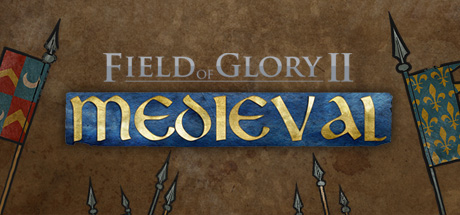Yesterday, we celebrated the Field of Glory Day, a live event with plenty of guests. As part of the events that happened during the day, we organized historical discussions that delved into the narratives and intricacies of historical strategy titles. These discussions were conducted in collaboration with the University of Winchester and other esteemed European academic institutions through a Twitter conference, titled "Middle Age in Modern Games”. We have joined this conference by featuring an interview with Richard Bodley Scott, the developer of Field of Glory II: Medieval, and Philippe Malacher, the developer of Field of Glory: Kingdoms.
You can find below the most interesting questions they have answered during the conference.
Field of Glory: Kingdoms
Wishlist the game.
How are the mechanics of Field of Glory: Kingdoms different from those of Field of Glory: Empires?
Philippe Malacher: Kingdoms features a unique Authority and Disorder system, which is different from the system in Field of Glory: Empires.
The Authority system functions as a resistance and rubber banding mechanism to prevent any one nation from getting too easily and permanently ahead in the game. This system allows players to maintain control over their population, promulgate edicts, and declare wars on their enemies. In addition to this, a Religion system has been added, creating natural opposition and tension between two major power blocks - the Christians and the Muslims. These tensions can escalate to wars with the specific purpose of fighting for the holy cities of Jerusalem and Mecca.
We also added some emphasis on how armies were organized during this time, with distinction between permanent units, levies, mercenaries. Each has advantages and drawbacks. This makes the game feels very different from its predecessor.
Why did you make these changes? More balanced gameplay? Match history better?
Philippe Malacher: The changes were made for the sake of historicity and flavor, as the medieval period was characterized by a strong hierarchy and feudal relations between liege lords and vassals. It was important to capture this as a game mechanism in Kingdoms.
The Authority and Disorder system prevents easy snowballing and captures the rise and fall of empires and kingdoms, while the Religion system adds an additional layer of realism and tension to the gameplay.
Overall, these changes were made to provide a more immersive and historically accurate gaming experience. Kingdoms also has likely a more thought-out and tightly meshed mechanisms than Empires, with a lot of moving parts, depending on each other. Hopefully players will find the interaction natural and logical, almost organic.
What are the most exciting features of Field of Glory: Kingdoms?
Philippe Malacher: The dynastic system is a major plus in the game, not only because you can enjoy being betrayed by your uncle while your heir is still a child. Even though the game's main features revolve around building a nation through civilian developments and conquests, you can now name important characters as peers of the realm, in charge of domains within your realm.
However, it's not a no-brainer choice each time. Will you empower unreliable individuals with troops and the possibility to become rich? Will you be paranoid and dismiss or even assassinate talented men because they are not as loyal as a dog? There are more choices, more paths to success or defeat. Another important set of improvements is the custom content made for Kingdoms for many nations.
There is probably a factor of ten or more between the specific content done for Venice, Byzantium, France, Castilla, and many more nations compared to Empires. This means many avenues of approach in how you play the game.
Field of Glory II: Medieval
Buy the game.
How do you pick which battles and factions to use for your scenarios?
Richard Bodley Scott: The historical battle scenarios (“Epic Battles”) are one of the most time-consuming aspects of game development. Apart from the research needed to create the battle map and the orders of battle, each scenario usually needs bespoke AI. This has to be tested and re-tested until the balance is right, and the player cannot analyse the AI’s behaviour, and then find a way to bypass its logic.
Hence we were limited to a finite number of historical battle scenarios in the base game (12) and each subsequent expansion (8). Each such module covered a specific time-period and geographical area, but we were still spoiled for choice for famous battles. Our final selections were designed to showcase the different military systems of the different factions existing in that era and area.
For the historically-based Campaigns, the situation was rather different. We did not attempt to replicate the exact circumstances of each historical battle, but instead used a script to define the circumstances of each battle, but then procedurally generated the battle map and the AI army. The composition of the player army would depend on events and choices earlier in the campaign. This removed the need for bespoke AI for each battle, as they were able to use the standard custom battle AI. This allowed us to have 4 or 5 historically-base campaigns in each module, each one with an average of 8 battles, based on historical strategic events, but not the exact details of each historical battle. We picked campaigns covering either major historical wars, the rise of major historical military systems (e.g. Swiss and Ottomans), or the careers of iconic leaders.
What were the biggest challenges in converting the ruleset of the Field of Glory board game to a digital format?
Richard Bodley Scott: The original Field of Glory was a tabletop miniatures game, usually played on a 6 x 4 foot (1.8 x 1.2 metre) table, using miniature figurines. What most people call board wargames are usually played on a hexagon gridded board with counters to represent troops.
The main difference is that tabletop miniatures games are usually analogue, played without any underlying grid. There have been attempts to design tabletop miniatures wargames played on a grid, but most people find that these rather defeat the point of playing with miniature figures, which is the spectacle of the thing.
Without any grid, units are moved by hand, using rulers, and it is easy to (inadvertently or deliberately) get their exact positions slightly wrong. This often leads to disputes as to whether units are in or out of range to shoot or charge. Such disputes can become quite acrimonious, even between friends. There are also often disputes about the exact meaning of the wording of the rules, as applied to a particular situation on the table.
A major advantage of a computerised version, therefore, is that the game rules are entirely operated by the computer, leaving no room for any such disputes in multiplayer games. And of course, AI allows a fully computerised opponent for single player games, with the AI following exactly the same set of rules as the player. (Difficulty settings can be managed by adjusting the “points” worth of troops available to the player and AI, rather than tweaking the game mechanisms in favour of the AI).
We wanted the game to “feel” as much like a tabletop miniatures game as possible, with the models used to represent the units designed to look like painted miniatures. For a grid we chose to use a square grid (hidden except when toggled on) rather than the hexagon grid that has become traditional in “serious” computer wargames, which have tended to follow the board wargames tradition, rather than the miniature wargames tradition.
Some people think that any “serious” wargame must be on a hexagon grid, forgetting that the only reason hexagon grids were developed in the first place, 50 years ago, was because square grid wargames – which did exist prior to the development of the hexagon grid - allowed longer diagonal moves than orthogonal. This is not an issue for computerised games, because the computer can easily adjust the “movement points” used for diagonal moves.
A square grid allows units to form up in proper battle lines, which looks much more realistic than the stepped line forced by a hexagon grid. It also allows movement and facing in 8 directions instead of 6.
How do you go about creating historically accurate unit models and mechanics?
Richard Bodley Scott: The Field of Glory design philosophy is a top-down approach to game mechanics and unit representation, rather than a bottom-up approach. By this I mean we do not start off with calculations of bow accuracy, rate of fire, armour penetration and suchlike considerations, but instead look at outcomes in recorded historical battles and attempt to design mechanisms that replicate those.
Some would regard the “bottom-up” approach to be the best route to “accuracy”, but it has the major problem that any errors in the assumptions made can get multiplied in the final mechanisms, to the point where the end result is not at all accurate.
Hence Field of Glory is designed to represent the interactions between different Medieval “troop-types”, such as Knights/Man-at-Arms, Spearmen, Crossbowmen, Archers, Pikemen etc. in a way that reflects actual historical battle outcomes.







